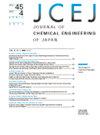混合催化剂催化二氧化碳氨甲烷化反应
IF 1.2
4区 工程技术
Q4 ENGINEERING, CHEMICAL
引用次数: 0
摘要
氨甲烷化是一种由二氧化碳和氨直接合成甲烷的反应。通过二氧化碳加氢合成甲烷的萨巴蒂尔反应,由于其热值较大,需要在反应堆中安装冷却设备。另一方面,氢应该作为氢能量载体(如氨)运输,并且必须注入能量才能从中产生氢。在氨甲烷化反应中,这两个反应同时进行,反应热低,可以用绝热反应器进行。本研究以氨分解催化剂和萨巴蒂尔反应催化剂为粉末状,对氨甲烷化反应进行了研究。氧化铝和钾改性的沉淀铁催化剂具有良好的氨分解活性。采用改性沉淀铁催化剂和Ni/CeO2催化剂组合的杂化催化剂进行氨甲烷化反应,但几乎没有甲烷生成。这可能是由于CeFeO3的形成(CeFeO3是一种复合氧化物)、CeO2孔隙的收缩和Ni的蚀变所致。因此,为了减少沉淀铁催化剂与Ni/CeO2催化剂之间的接触点数量,将它们形成颗粒混合进行氨甲烷化反应。然而,虽然产生了甲烷,但没有获得足够的产量。Ni/Al2O3催化剂在氨分解反应中也表现出良好的活性。采用Ni/Al2O3和Ni/CeO2混合催化剂进行氨甲烷化反应,甲烷产率达到60%以上。本文章由计算机程序翻译,如有差异,请以英文原文为准。
Ammonia Methanation of Carbon Dioxide with a Hybrid Catalyst
Ammonia methanation is a reaction that synthesizes methane directly from carbon dioxide and ammonia. The Sabatier reaction, which synthesizes methane by hydrogenating carbon dioxide, requires a cooling facility in the reactor due to its large heat value. On the other hand, hydrogen is supposed to be transported as a hydrogen energy carrier such as ammonia, and energy must be injected to produce hydrogen from them. The ammonia methanation reaction, in which these two reactions proceed simultaneously, has a low heat of reaction and can be constructed using an adiabatic reactor. In this study, the ammonia methanation reaction with a hybrid catalyst that combines an ammonia decomposition catalyst and a Sabatier reaction catalyst as powders was investigated. Precipitated iron catalyst modified with alumina and potassium showed good activity for ammonia decomposition. Ammonia methanation reaction was carried out using a hybrid catalyst combining modified precipitated iron catalyst and Ni/CeO2 catalyst, but almost no methane was obtained. This is presumed to be due to the formation of CeFeO3, which is a composite oxide, the shrinkage of the pores of CeO2, and the alteration of Ni. Therefore, in order to reduce the number of contact points between the precipitated iron catalyst and the Ni/CeO2 catalyst, they were formed into particles and mixed to conduct the ammonia methanation reaction. However, although methane was produced, a sufficient yield was not obtained. Ni/Al2O3 catalyst also showed good activity for ammonia decomposition reaction. A hybrid catalyst consisting of Ni/Al2O3 and Ni/CeO2 catalysts was used for the ammonia methanation reaction, and a high methane yield of over 60% was obtained.
求助全文
通过发布文献求助,成功后即可免费获取论文全文。
去求助
来源期刊

Journal of Chemical Engineering of Japan
工程技术-工程:化工
CiteScore
1.70
自引率
12.50%
发文量
51
审稿时长
1.9 months
期刊介绍:
The Journal of Chemical Engineering of Japan (JCEJ) is a monthly publication in English of the Society of Chemical Engineers, Japan. The first issue appeared in 1968. JCEJ publishes timely original research in the broad field of chemical engineering ranging from fundamental principles to practical applications. JCEJ is an international research journal and invites your contributions and subscriptions.
All areas of chemical engineering are covered, including:
Physical Properties and Physical Chemistry,
Transport Phenomena and Fluid Engineering,
Particle Engineering,
Separation Engineering,
Thermal Engineering,
Chemical Reaction Engineering,
Process Systems Engineering and Safety,
Biochemical,
Food and Medical Engineering,
Micro and Nano Systems,
Materials Engineering and Interfacial Phenomena,
Energy, Environment, and
Engineering Education.
 求助内容:
求助内容: 应助结果提醒方式:
应助结果提醒方式:


